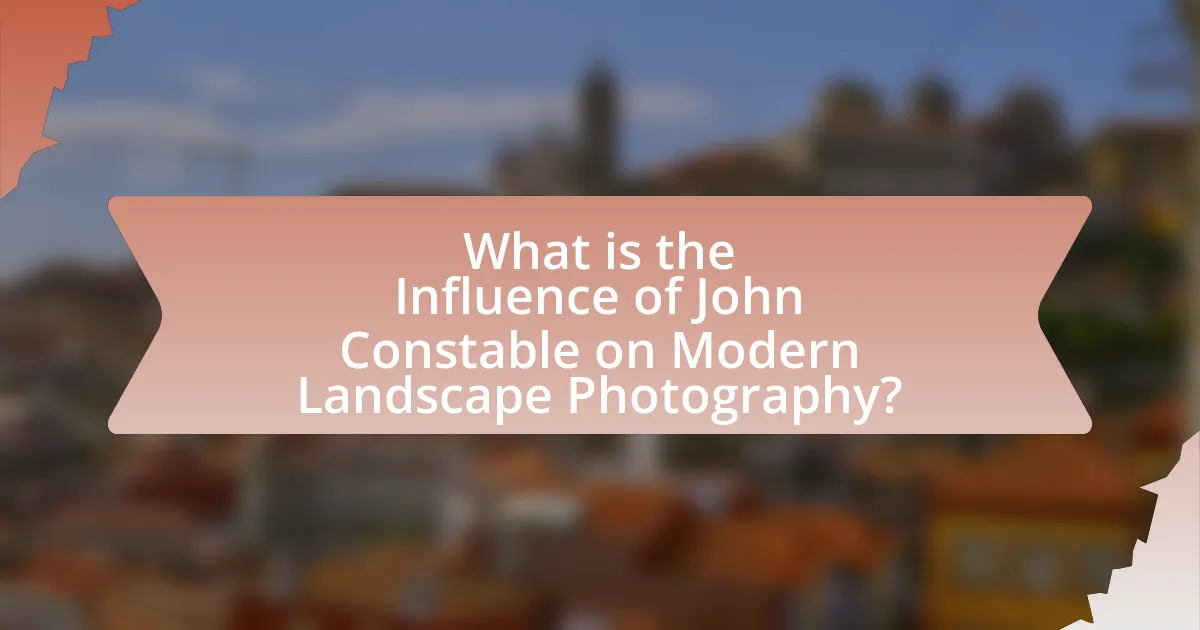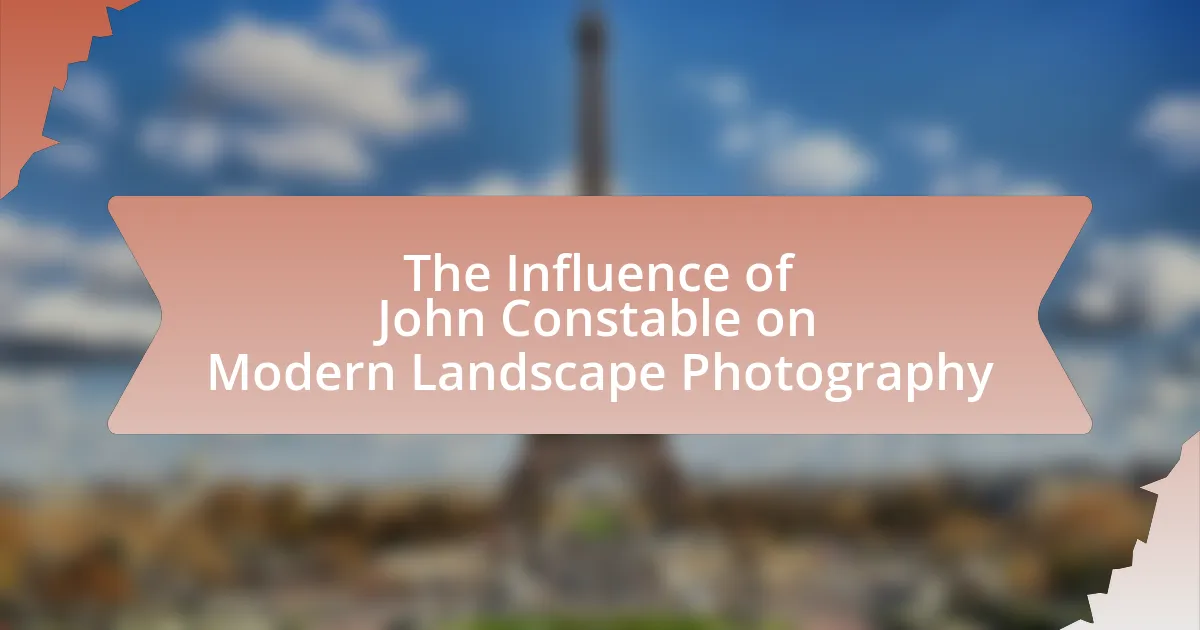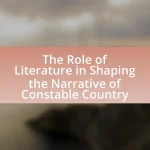John Constable is a pivotal figure in landscape art, whose innovative techniques and emphasis on naturalism have profoundly influenced modern landscape photography. His approach, characterized by the use of light, color, and emotional resonance, laid the groundwork for contemporary photographers to explore similar themes. The article examines Constable’s techniques, such as plein air painting and the depiction of atmospheric effects, and highlights how these methods resonate in the works of modern photographers. It also discusses the historical context of Constable’s work, his unique style compared to contemporaries, and the emotional responses his landscapes evoke in viewers, illustrating his lasting legacy in the field of landscape photography.

What is the Influence of John Constable on Modern Landscape Photography?
John Constable significantly influenced modern landscape photography through his innovative approach to capturing natural scenes. His emphasis on light, atmosphere, and the emotional resonance of landscapes laid the groundwork for photographers to explore similar themes. Constable’s technique of plein air painting, where he painted outdoors to capture the changing light and weather conditions, inspired photographers to adopt similar practices, leading to a more authentic representation of nature. His works, such as “The Hay Wain,” demonstrate a keen observation of the interplay between light and landscape, which modern photographers emulate to evoke mood and depth in their images. This legacy is evident in the works of contemporary landscape photographers who prioritize naturalism and emotional engagement, reflecting Constable’s enduring impact on the genre.
How did John Constable’s artistic style shape landscape photography?
John Constable’s artistic style significantly shaped landscape photography by emphasizing naturalism and the emotional resonance of landscapes. His use of light, color, and atmospheric effects in paintings, such as “The Hay Wain,” influenced photographers to capture the essence of nature with similar authenticity. Constable’s focus on plein air painting encouraged subsequent landscape photographers to seek out natural settings and depict them in a way that conveyed mood and realism, leading to a more expressive and personal approach in the medium. His techniques, including the depiction of changing weather and light conditions, laid the groundwork for later photographers like Ansel Adams, who adopted similar principles to evoke emotion through landscape imagery.
What techniques did Constable use that are reflected in modern photography?
John Constable employed techniques such as the use of natural light, atmospheric effects, and a focus on capturing the emotional resonance of landscapes, which are reflected in modern photography. His emphasis on plein air painting allowed him to observe and depict the changing qualities of light and weather, influencing contemporary photographers to prioritize natural conditions in their work. Additionally, Constable’s ability to convey mood through color and composition has inspired modern photographers to explore similar emotional depth in their landscape imagery.
How did Constable’s use of light and color influence contemporary photographers?
John Constable’s use of light and color significantly influenced contemporary photographers by introducing a naturalistic approach to landscape imagery. His innovative techniques, such as capturing the effects of changing light and atmospheric conditions, encouraged photographers to explore similar methods in their work. For instance, Constable’s emphasis on the interplay of light and shadow, as seen in his paintings like “The Hay Wain,” inspired photographers to focus on natural lighting to create depth and mood in their images. This approach has been foundational in modern landscape photography, where the accurate representation of light and color is crucial for evoking emotion and realism.
Why is John Constable considered a pivotal figure in landscape art?
John Constable is considered a pivotal figure in landscape art due to his innovative approach to capturing the natural world, particularly through his emphasis on light, atmosphere, and emotional resonance. His paintings, such as “The Hay Wain” and “Dedham Vale,” showcase a realistic portrayal of rural life and the English countryside, which influenced subsequent generations of artists. Constable’s technique of using plein air studies allowed him to depict the changing effects of weather and light, establishing a foundation for modern landscape photography. His work emphasized the importance of personal experience and emotional connection to the landscape, which has become a key aspect of contemporary landscape art and photography.
What historical context surrounded Constable’s work?
John Constable’s work was surrounded by the historical context of early 19th-century England, marked by the Industrial Revolution and Romanticism. The Industrial Revolution transformed the English landscape, leading to urbanization and changes in agricultural practices, which Constable sought to capture in his paintings, emphasizing the beauty of rural life. Additionally, the Romantic movement influenced his focus on nature and emotional expression, as artists reacted against the industrialization and sought to convey the sublime aspects of the natural world. Constable’s dedication to plein air painting and his innovative techniques, such as the use of color and light, reflected these historical shifts, positioning him as a pivotal figure in the transition to modern landscape representation.
How did Constable’s approach differ from his contemporaries?
John Constable’s approach differed from his contemporaries primarily through his emphasis on capturing the natural landscape with a focus on light, atmosphere, and emotional resonance. While many of his contemporaries, such as J.M.W. Turner, leaned towards dramatic and romanticized interpretations of nature, Constable prioritized realism and the depiction of everyday scenes, often painting en plein air to observe the changing effects of light and weather directly. His technique involved a meticulous study of the English countryside, which he rendered with a sense of immediacy and intimacy, as seen in works like “The Hay Wain.” This dedication to realism and the emotional connection to the landscape set him apart and influenced future generations of landscape photographers, who sought to convey similar authenticity and emotional depth in their work.
What are the key elements of Constable’s landscapes that resonate today?
The key elements of Constable’s landscapes that resonate today include his emphasis on naturalism, emotional depth, and the interplay of light and atmosphere. Constable’s commitment to depicting the English countryside with authenticity allows contemporary viewers to connect with the landscapes on a personal level. His use of vibrant colors and dynamic skies captures the transient qualities of nature, which remains relevant in modern landscape photography. Additionally, Constable’s focus on everyday scenes and rural life reflects a timeless appreciation for the beauty found in ordinary settings, influencing current photographers to seek authenticity in their work.
How does the depiction of nature in Constable’s work compare to modern interpretations?
John Constable’s depiction of nature emphasizes realism and emotional connection, contrasting with modern interpretations that often prioritize abstraction and environmental commentary. Constable’s landscapes, characterized by meticulous attention to light, atmosphere, and local scenery, reflect a deep appreciation for the English countryside, as seen in works like “The Hay Wain.” In contrast, contemporary landscape photography frequently incorporates digital manipulation and conceptual themes, focusing on issues such as climate change and urbanization. This shift highlights a broader societal awareness and a departure from the intimate, personal connection to nature that Constable exemplified.
What emotional responses do Constable’s landscapes evoke in viewers?
Constable’s landscapes evoke feelings of nostalgia, tranquility, and a deep connection to nature in viewers. His use of light, color, and composition creates serene and idyllic scenes that often remind viewers of pastoral beauty and simpler times. For instance, his painting “The Hay Wain” captures a peaceful rural setting, eliciting a sense of calm and reflection. This emotional response is reinforced by Constable’s ability to depict atmospheric effects and natural elements, which resonate with the viewer’s own experiences and memories of the countryside.
How has the legacy of John Constable been preserved in modern photography?
The legacy of John Constable has been preserved in modern photography through the emphasis on natural light and atmospheric conditions in landscape imagery. Photographers today often draw inspiration from Constable’s techniques, such as his use of color and texture to convey emotion and realism in nature. For example, contemporary landscape photographers like Michael Kenna and David Muench incorporate similar principles of composition and light that reflect Constable’s influence. Additionally, exhibitions and publications that celebrate Constable’s work continue to educate new generations of photographers about his contributions, ensuring that his approach to capturing the essence of the landscape remains relevant.
What specific modern photographers have been influenced by Constable?
Specific modern photographers influenced by John Constable include David Hockney and Richard Misrach. David Hockney’s landscape works often reflect Constable’s emphasis on natural light and color, while Richard Misrach’s large-scale photographs echo Constable’s romantic portrayal of the landscape. Both artists have acknowledged Constable’s impact on their approach to capturing the essence of nature in their photography.
How do these photographers incorporate Constable’s techniques into their work?
Photographers incorporate Constable’s techniques into their work by emphasizing natural light, atmospheric effects, and a focus on the emotional resonance of landscapes. They often utilize soft brushwork and a palette that mirrors Constable’s use of color to capture the essence of the scene, creating a sense of depth and realism. For instance, contemporary photographers may adopt similar compositional strategies, such as foreground interest and balanced elements, to evoke the same feelings of tranquility and connection to nature that Constable achieved in his paintings. This approach is validated by the ongoing study of landscape photography, which highlights the enduring impact of Constable’s methods on visual storytelling and composition in modern practices.
What practical tips can photographers learn from John Constable’s approach?
Photographers can learn to prioritize natural light and atmospheric conditions from John Constable’s approach. Constable meticulously observed how light interacted with landscapes, often painting en plein air to capture the changing effects of weather and time of day. This practice emphasizes the importance of being present in the environment and adapting to its dynamic qualities, which can enhance the emotional depth and realism in photography. Additionally, Constable’s use of color and texture to convey mood encourages photographers to experiment with their palettes and compositions, focusing on the interplay between elements in a scene to create compelling narratives.
How can understanding Constable’s techniques enhance landscape photography today?
Understanding Constable’s techniques can enhance landscape photography today by emphasizing the importance of capturing natural light and atmospheric conditions. Constable’s approach involved studying the effects of light on landscapes, which led to a more dynamic representation of nature. His use of color and brushwork to depict the changing skies and seasons can inspire photographers to focus on the subtleties of light and shadow in their compositions. For instance, Constable often painted en plein air, allowing him to observe and replicate the immediate effects of weather and time of day, a practice that modern photographers can adopt to achieve more authentic and evocative images. This technique not only improves the aesthetic quality of photographs but also deepens the emotional connection viewers have with the landscape, reflecting Constable’s belief in the power of nature to evoke feelings.
What common mistakes should photographers avoid when emulating Constable’s style?
Photographers should avoid overly literal interpretations of Constable’s style, as this can lead to a lack of originality and personal expression. Emulating Constable requires understanding his techniques, such as the use of light and atmosphere, rather than simply replicating his compositions. Additionally, neglecting the importance of capturing the emotional resonance of a scene, which was central to Constable’s work, can result in flat and uninspired images. Constable’s paintings often featured dynamic skies and rich textures, so failing to incorporate these elements can diminish the impact of the photograph. Lastly, photographers should be cautious of using overly saturated colors, as Constable’s palette was more subdued and naturalistic, reflecting the true essence of the landscape.


